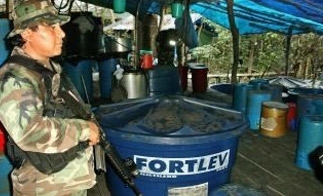Bolivia announced that it will open investigations into links between corrupt officials and foreign drug trafficking organizations in the eastern department of Santa Cruz, reopening the question of how far international cartels have a presence in the country.
The Bolivian government formally asked the Santa Cruz Attorney General’s Office to investigate ties between local officials and foreign drug trafficking organizations. Documents containing allegations against at least six officials were handed to prosecutor Marco Antonio Rodriguez on August 14, reported Milenio.
Among the accused are officers belonging to Santa Cruz’s anti-narcotics police unit (FELCN), international police agency Interpol, a former air force colonel, and members of the Santa Cruz city police force. They are suspected of colluding with Colombian, Mexican and Brazilian drug traffickers in networks that operated throughout the country, passing through La Paz and the departments of Cochabamba and Santa Cruz, according to La Razon.
InSight Crime Analysis
The issue of whether foreign gangs have a presence in Bolivian territory has been a contentious point for the administration of President Evo Morales. Colombian Foreign Minister Maria Angela Holguin stated in June that Colombian drug gangs were present in Bolivia, and there have even been reports that the head of Mexico’s Sinaloa Cartel, Joaquin “El Chapo” Guzman, had stayed in the country at some point. Though Morales has recognised that Mexican and Colombian traffickers operate in Bolivia, he stated he couldn’t support Holguin’s claims of a fully-fledged cartel presence. Bolivian Social Defense Deputy Minister Felipe Caceres referred to the traffickers as being mere “emissaries” for cartels.
Santa Cruz is a key location for the drug trade thanks to its location between Bolivia’s largest coca-producing department, Cochabamba, and Latin America’s largest consumer of cocaine, Brazil. In one operation in May this year, more than 90 cocaine labs were dismantled and a clandestine airstrip for drug flights was destroyed in Santa Cruz. Colombian intelligence officials have estimated that as many as 3,000 Colombian traffickers may operate there, and there is evidence that Brazilian gangs the Red Command (Comando Vermelho) and First Capital Command (PCC) also run networks from the department into Brazil.
Bolivia appears to be growing in importance to foreign traffickers. Mexican publication El Universal reported last month that Bolivia may now be the second largest supplier of cocaine to Mexican cartels after Colombia, based on information it received from the Drug Enforcement Administration (DEA) and the UN’s Office on Drugs and Crime (UNODC). Mexican cartels may have also installed laboratories to process synthetic drugs in the country, according to the report.
In a speech to Congress earlier this month, Morales stated that drug trafficking and corruption were the two biggest problems facing the country. Accusations of narco-corruption have hit high-level officials, with former drug czar Rene Sanabria reportedly declaring earlier this year that the government was actively hindering investigations into corruption. Sanabria is currently serving a 15 year prison term in the US for cocaine smuggling.
The country’s presidency minister has also been accused of having ties to a jailed Brazilian cocaine smuggler. However, some of the allegations that the government is failing to investigate drug corruption cannot be detached from political motives.

